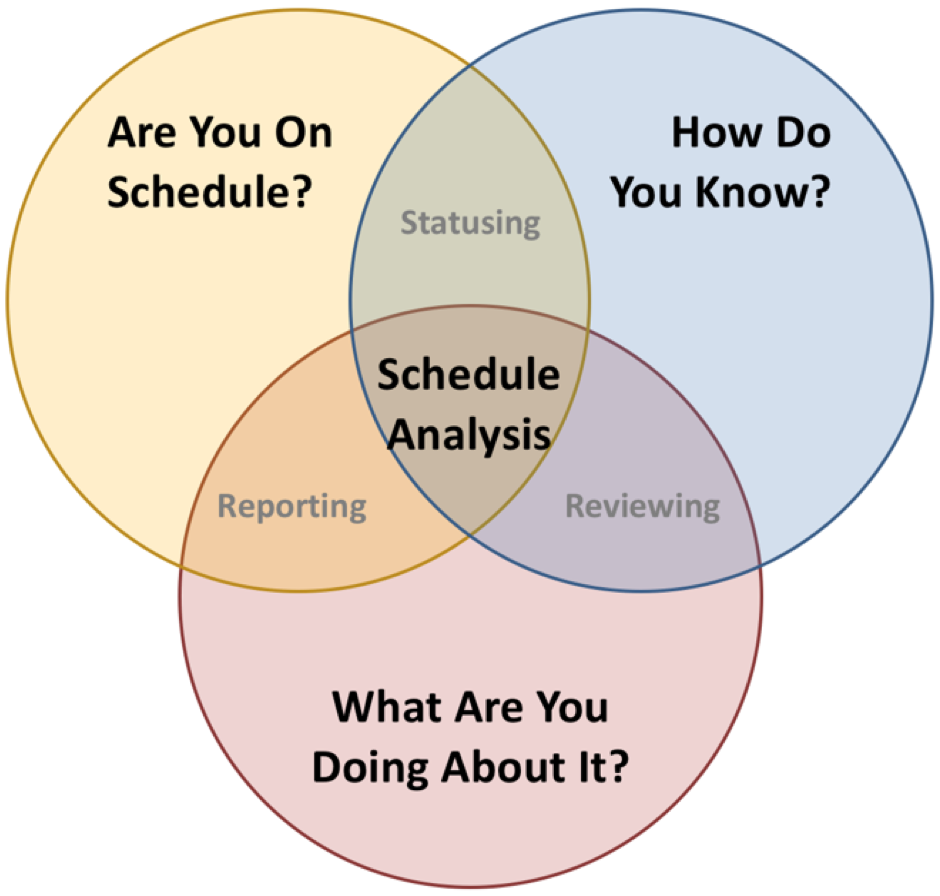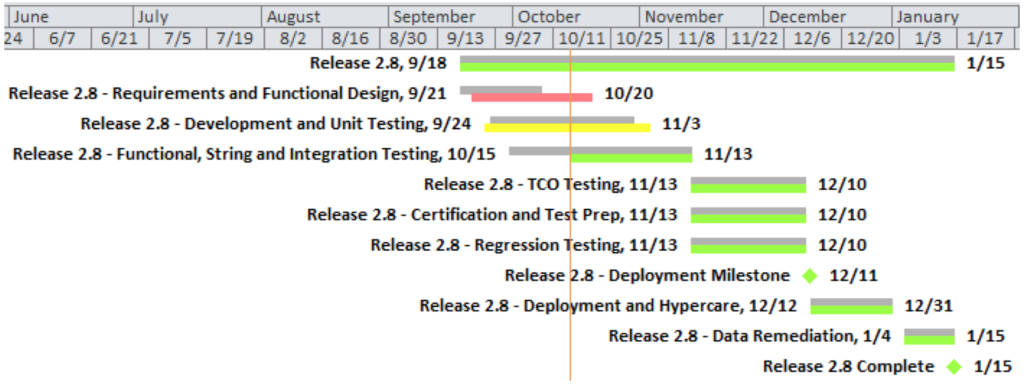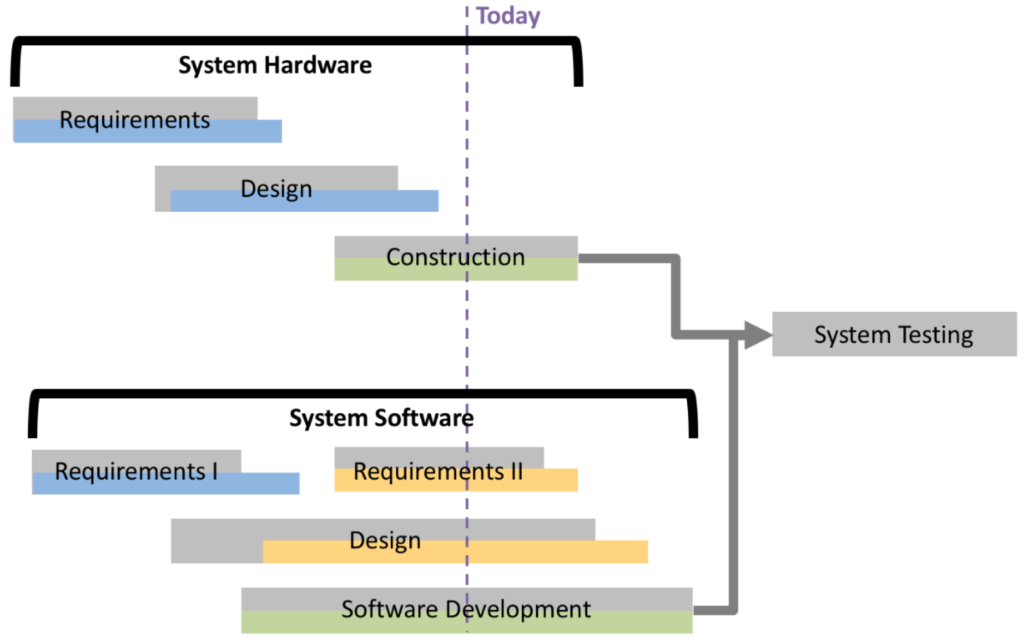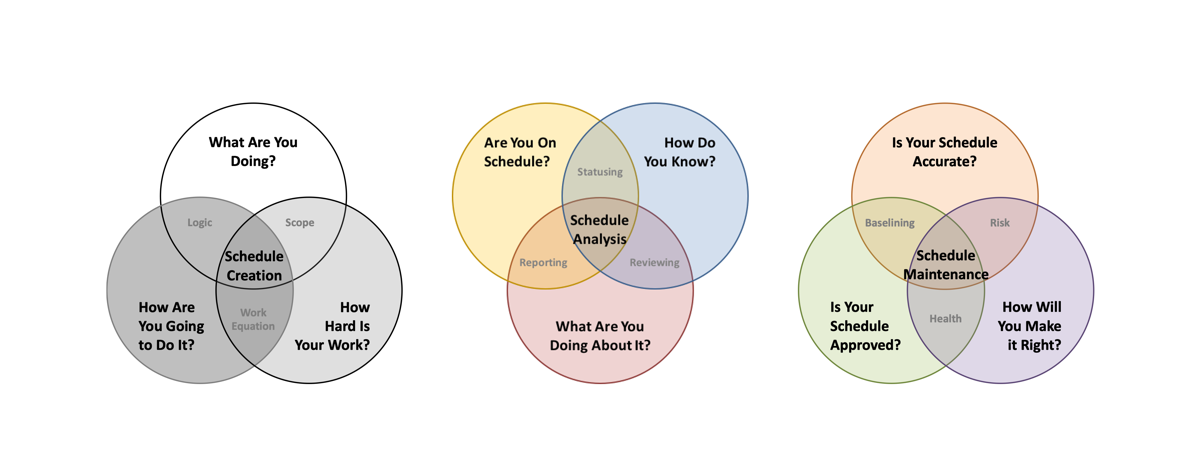Most people who have worked on a project know that the Schedule Manager studies the schedule, looking for ways to get delayed work back on track. However, reviewing the schedule is only a piece of the whole. So, what is schedule analysis?
Most simply, schedule analysis answers the three questions in Figure 1. These questions, seemingly straight forward, take real work by the entire team to answer. This article will discuss schedule analysis’s imperative to provide decision quality information, and how schedule analysis fits into the larger role of project management.

Forecasting to Eliminate Surprises
Knowing that a significant deadline has been missed is rarely helpful after the fact. However, any missed deadline can be avoided or mitigated given enough forewarning. Consider the scenario depicted in Figure 2. The Requirements and Functional Designphase is expected to finish three weeks late, postponing completion of Development and Unit Testing, and the start of Functional, String and Integration Testing. But deployment is still expected to finish on time. Is the project team thinking wishfully, or is there credible reason to believe they can recover?

The summary project view in Figure 2 doesn’t offer enough information for us to know the answer. However, even from the summary level we can spot where we should be focusing our analysis. Schedule Reviewing Techniques will explore how to precisely target your analysis at the delays that matter and pose questions which will expose the options a project team can make to control the outcome.

Establishing Trends to Predict the Distant Future
The inherent unpredictability of projects and project environments, makes long-range forecasting difficult. Thoroughly analyzing a detailed schedule may accurately predict the project’s future six weeks from now. That doesn’t help much when trying to forecast a finish date eighteen months away. However, even if there is not a single critical path spanning the eighteen months, a Schedule Manager can offer insight into whether the plan’s success is realistic or probable.
Figure 3 depicts an eighteen-month hardware and software project with multiple Requirements, Design, Development/Construction, and Testing phases. The first two hardware phases took longer than expected, however construction is expected to complete on time. Now that the hardware design is complete, the experienced contractor can proceed apace. Software development is not going nearly as well. Delays during the initial requirements phase postponed the start of the design phase. The second requirements phase and the design phase are expected to finish late. Despite delays, both teams forecast that they will finish on time. Are the hardware and software team’s claims equally credible?

Though the high-level schedule forecasts that the project will get back on track by the time system testing begins, an experienced Schedule Manager would test their suspicions. The burden of proof rests with the Project Manager and the team leads to convince all stakeholders that the schedule really is recoverable.
Whether the prediction is six weeks out, or sixteen months out, the Schedule Manager’s line of inquiry remains the same. Are you on schedule? How do you know? What are you doing about it? Honest recognition of a problem halfway through a long project gives managers ample time to seek remedies. The earlier the warning, the more options the project team will have to self-rescue.

Facilitating Communication
Ask a veteran manager “What is a project schedule?”, and they may offer one of the following well known answers.
- A project schedule is a tool for tracking a project’s progress.
- A project schedule is an output of a schedule model that presents linked activities with planned dates, durations, milestones, and resources.1Project Management Institute, A Guide to the Project Management Body of Knowledge. Sixth Edition, 2017.
- A project schedule is a document that integrates the planned work, and the resources necessary to accomplish that work, which should be the focal point of program management.2US Government Accountability Office, GAO Schedule Assessment Guide. https://www.gao.gov/products/GAO-16-89G, December 2015.
These answers are true and valid. But above all else, a project schedule is a communication tool. It allows teams to convey information amongst one another about how their work is going, and when it will complete.
Supporting Team Leads
Schedule analysis’s end goal is to provide decision quality information to project teams, allowing them to control their work’s trajectory. That process begins by making them aware of their blind spots. Ask a team lead whether they are on schedule, and they will usually say “yes”. When asked how they know they are on schedule, they may answer unconvincingly. This is not necessarily because the team lead is out of touch, or because they are trying to cover their tracks. Managers are busy. They often do not have time to hunt for problems that aren’t waving a bright red flag. Unfortunately, most schedule delays are unavoidable by the time any flags go up.
A Schedule Manager’s most important responsibility is to help other managers spot threats to the schedule before red flags go up. Once identified, Schedule Managers can help team leads answer schedule analysis’s third question, “What are you doing about it?”.
Inter-team Communication
Schedule Managers are responsible for understanding every team’s progress. The steps necessary to do so drive inter-team communication. If every team lead must report to the Schedule Manager and vice versa, the Schedule Manager becomes a communication hub for the project. This allows Schedule Mangers to convey every teams’ responsibilities and needs to other relevant teams, and gives team leads a reliable, peer reviewed knowledge source about the entire project. The more positive lines of communication that are available to project stakeholders, the lower the odds that a project team gets left in the dark or caught by surprise.

In Figure 4, suppose the Oracle Development Team is running irrevocably late. This will impact the Quality Assurance, Testing, and SAP Development Teams’ schedules. But with early enough warning, the SAP Team can halt work on their SAP-to-Oracle interface, and shift focus to tasks they were planning to work later but can be completed now. The Testing Team, now aware that they won’t get the completed system on time, can reorganize their testing strategy to tackle integrated system testing last. The Quality Assurance Team may make similar adjustments. The Oracle Team’s delays will still impact the project. However, comprehensive schedule analysis and reporting can make the difference between finding good options and having no options.
Now suppose that spreading word of the delay was left to the Oracle team lead. Leading a project team often creates tunnel vision. The Oracle project manager probably has limited awareness how their own delays will affect other teams’ workflows. That becomes even more true when working through a crisis. Even if the Oracle manager is aware of and willing to admit their team’s delay, the effort they would spend spreading the word distracts the manager from getting their team back on track. Furthermore, they may not even convey the right information to their peers, because they do not know what intel is most relevant. The Schedule Manager, with their broader and more focused view of the schedule, can supply a far more candid and comprehensive assessment to affected project teams.
Reporting to Inform Decision Making
Even the most detailed schedules answer only a handful of specific questions.
- Do we have a plan?
- What should we work on next?
- Do we have the right number of people?
- Is there a bottleneck, or a lull?
- Can we finish when planned?
- What happens if we finish late, or early?
- How can we recover?
But a proper schedule analysis answers these questions comprehensively and in depth. The culmination of every schedule analysis cycle is the verbal or written reports resulting from statusing and reviewing the project schedule. Actionable knowledge conveyed in these reports will allow leadership to respond to unplanned circumstances that arise on any project. Knowing where the project is today, and where it will be tomorrow significantly elevates all stakeholders’ confidence that their decisions will be informed ones.
Next Steps
This article has overviewed how short and long range schedule analysis can provide project teams and other stakeholders with critical information which allows them to steer the course of their work. Schedule Analysis Principles will outline why the recurring steps of schedule analysis are essential for ensuring a project’s timely success.
